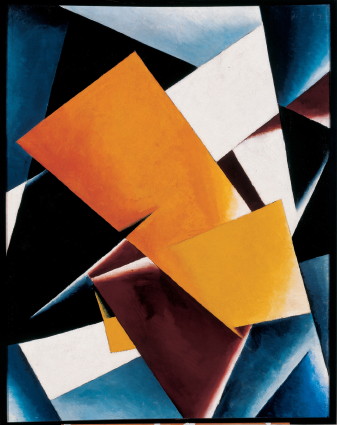Rodchenko and Popova: Defining Constructivism at Tate Modern
Liubov Popova and Aleksandr Rodchenko were pivotal Constructivists following the Russian Revolution and together embraced advertising, architecture, film, painting, theatre and textile design.

This exhibition is naturally dominated by Rodchenko who lived much longer than Popova. She died early in 1924 having enjoyed the novelty of equal status with men working in the same area of influence.
Roped off for special protection in gallery seven are three blank canvasses: Rodchenko's triptych Pure Red Colour, Pure Yellow Colour, Pure Blue Colour. These drew the most attention at a Moscow exhibition in 1921 intended as a farewell to painting.
Some may say that this resembles the recent 'modern art' displayed in Britain. But his 1919 newspaper kiosk design looks thirty years ahead to the Festival of Britain.
We see the two artists working on the new calendar with Popova decorating Moscow's city hall for May Day and Rodchenko producing a poster advertising Red October Biscuits for the fifth anniversary of the Revolution.
Popova's hammer and sickle fabric is probably the most attractive representation of the new regime's logo ever produced.
The last room is a reconstruction of the Workers Club designed by Rodchenko to be showcased by the Soviet government at the 1925 International Exhibition of Decorative Arts and Modern Industry in Paris.
Visitors to the Tate exhibition can again sit in the chairs at the long reading desk or try the seats at the chess table. They are incredibly uncomfortable.
Rodchenko's work appears confident but in 1927 he wrote: "When I look at the number of paintings I have painted, I sometimes wonder what I shall do with them, there are over ten years work in them. But they are as useless as a church. They serve no purpose whatsoever."
Later the show will travel to the Greek State Museum of Contemporary Art in Thessaloniki and the Museo Nacional Centro de Arte Reina Sofia in Madrid which is named after the Greek-born Queen. This exhibition is only possible thanks to George Costakis, a Greek born in Russia, who tracked down Rodchenko's forgotten art and presented part of his collection to a Moscow museum before retiring to Greece in 1977.
• The Tate shop is selling a Popova cup and saucer (£32) and a Rodchenko book cover fridge magnet (£3).
Comments
Share
The SE1 website is supported by people like you
Follow us
Email newsletter
For the latest local news and events direct to your inbox every Monday, you need our weekly email newsletter SE1 Direct.

